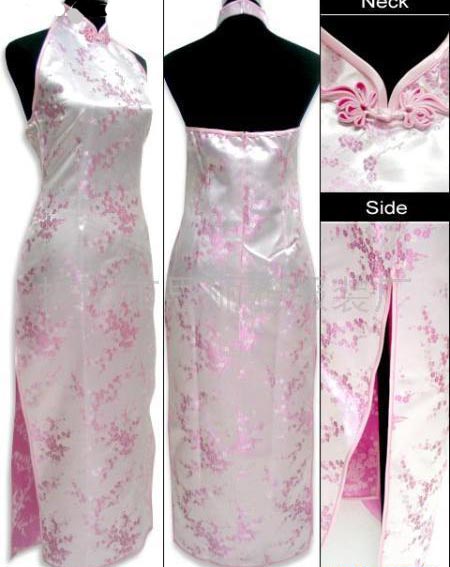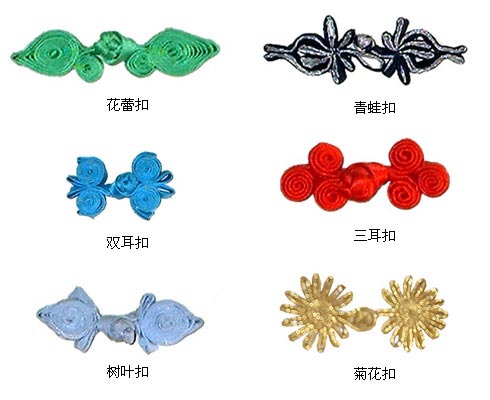
Which kind of costume do you think deserves such adjectives? Qipao, the classic dress for Chinese women. Definitely. As a combination of the elaborate elegance of Chinese tradition and unique elements of style, Qipao is one of the most versatile costumes in the world. It can be high-necked or collarless, long or short, some with full, medium, short or even no sleeves at all - to suit different occasions, weather and individual tastes.

Though straight tailoring from top to bottom, the Qipao can fully display all women's modesty, softness and beauty. A suitable Qipao is like an intimate friend of a women, from which you can know her temperament, her graceful and refined manner. Qipao is a tale of elegant and gentle.
The cheongsam, or Qipao in Chinese, is evolved from a kind of ancient clothing of Manchu ethnic minority. In ancient times, it generally referred to long gowns worn by the people of Manchuria, Mongolia and the Eight-Banner.

In the early years of the Qing Dynasty (1644-1911), long gowns featured collarless, narrow cuff in the shape of a horse's hoof, buttons down the left front, four slits and a fitting waist. Wearers usually coiled up their cuff, and put it down when hunting or battling to cover the back of hand. In winter, the cuff could serve to prevent cold. The gown had four slits, with one on the left, right, front and back, which reached the knees. It was fitted to the body and rather warm. Fastened with a waistband, the long gown could hold solid food and utensils when people went out hunting. Men's long gowns were mostly blue, gray or green; and women's, white.
Another feature of Manchu cheongsam was that people generally wore it plus a waistcoat that was either with buttons down the front, a twisted front, or a front in the shape of lute, etc.

When the early Manchu rulers came to China proper, they moved their capital to Beijing and cheongsam began to spread in the Central Plains. The Qing Dynasty unified China, and unified the nationwide costume as well. At that time, men wore a long gown and a mandarin jacket over the gown, while women wore cheongsam. Although the 1911 Revolution toppled the rule of the Qing (Manchu) Dynasty, the female dress survived the political change and, with succeeding improvements, has become the traditional dress for Chinese women.
Till the 1930s, Manchu people, no matter male or female, all wore loose-fitting and straight-bottomed broad-sleeved long gowns with a wide front. The lower hem of women's cheongsam reached the calves with embroidered flower patterns on it, while that of men's cheongsam reached the ankles and had no decorative patterns.
From the 1930s, cheongsam almost became the uniform for women. Folk women, students, workers and highest-tone women all dressed themselves in cheongsam, which even became a formal suit for occasions of social intercourses or diplomatic activities. Later, cheongsam even spread to foreign countries and became the favorite of foreign females.
After the 1940s, influenced by new fashion home and abroad, Manchu men's cheongsam was phased out, while women's cheongsam became narrow-sleeved and fitted to the waist and had a relatively loose hip part, and its lower hem reached the ankles. Then there emerge various forms of cheongsams we see today that emphasize color decoration and set off the beauty of the female shape.
Why do Han people like to wear the cheongsam? The main reason is that it fits well the female Chinese figure, has simple lines and looks elegant. What's more, it is suitable for wearing in all seasons by old and young.
The cheongsam can either be long or short, unlined or interlined, woolen or made of silk floss. Besides, with different materials, the cheongsam presents different styles. Cheongsams made of silk with patterns of flowerlet, plain lattices or thin lines demonstrate charm of femininity and staidness; those made of brocade are eye-catching and magnificent and suitable for occasions of greeting guests and attending banquets. When Chinese cheongsams were exhibited for sales in countries like Japan and France, they received warm welcome from local women, who did not hesitate to buy Chinese cheongsams especially those top-notch ones made of black velour interlined with or carved with golden flowers. Cheongsam features strong national flavor and embodies beauty of Chinese traditional costume. It not only represents Chinese female costume but also becomes a symbol of the oriental traditional costume.
Patterns on Qipao
Blossom peony
The peony, also known as (fuguihua) "flower of riches and honour" , is one of the smallest living creature national emblems in China. The peony is usually patterned on Qipao, not only because of its splendid blooms but also its mysterious connection with the renowned Chinese ancient Beauty Xi Shi. Xi Shi sacrificed herself for her beloved Yue people, who finally turned their back on her and discarded her cruelly. There is a similarity between peony and Xi shi, the same holy, brave and sympathetic beauty. The peony ranks a unique place in all flora, just like Xi Shi in all ancient belles. As a famous peot in Dang Dynasty, Bi Juyi, put it, only Xi Shi deserves the crown of Beauty, and peony of flora. When a women wear peony Qipao, doesn’t it have a feeling of irreplaceable sense of beauty?
Dragons
The dragon is a legendary creature of which some interpretation or depiction appears in almost every culture worldwide. The physical description and supposed abilities of the creature vary immensely according to the different cultures in which it appears. However, the unifying feature of almost all interpretations is it being a serpentine or otherwise reptilian monster (or at least possessing a serpentine, reptilian part or trait), and often possessing magical or spiritual qualities.
Chinese Myth
Chinese dragons, and Oriental dragons generally, are usually seen as benevolent, whereas European dragons are usually malevolent though there are exceptions.
Dragons are particularly popular in China and the 5-clawed dragon was a symbol of the Chinese emperors, with the phoenix or fenghuang the symbol of the Chinese empress. Dragon costumes manipulated by several people are a common sight at Chinese festivals.

Phoenix
A phoenix is a mythical bird with a tail of beautiful gold and red plumage (or purple and blue, by some sources ). It has a 1,000 year life-cycle, and near the end the phoenix builds itself a nest of cinnamon twigs that it then ignites; both nest and bird burn fiercely and are reduced to ashes, from which a new, young phoenix or phoenix egg arises, reborn anew to live again. The new phoenix is destined to live as long as its old self. In some stories, the new phoenix embalms the ashes of its old self in an egg made of myrrh and deposits it in the Egypt city of Heliopolis (sun city in Greek). The bird was also said to regenerate when hurt or wounded by a foe, thus being almost immortal and invincible—it is also said that it can heal a person with a tear from its eyes and make them temporarily immune to death; a symbol of fire and divinity.
How to wear
As for daily casual wear, in summer, you can choose some thin fabrics such as pure cotton delaine printed with little flowers, sack and yarn cloth, silk, and poplin.
In spring and winter, there is chemical fiber or blended cloth like gleaming silk and thinner woolen cloth.
If for formal affairs like ceremonies or performances, in summer, you should select pure silk crape de Chine, thin silk, which are soft, light and cool since it won't stick to your body.
For spring and winter, satin and velour are the best: tapis, treasures, crape and spun gold damask.
Qipao is about imagination, characterized by estern mysterious culture. It tightly fitted women’s figure, just like a gentle watery eastern belle. The texture of silk implies the softy glossy skin of the beauty. When you feel it with your heart, you can even sense the body temperature.